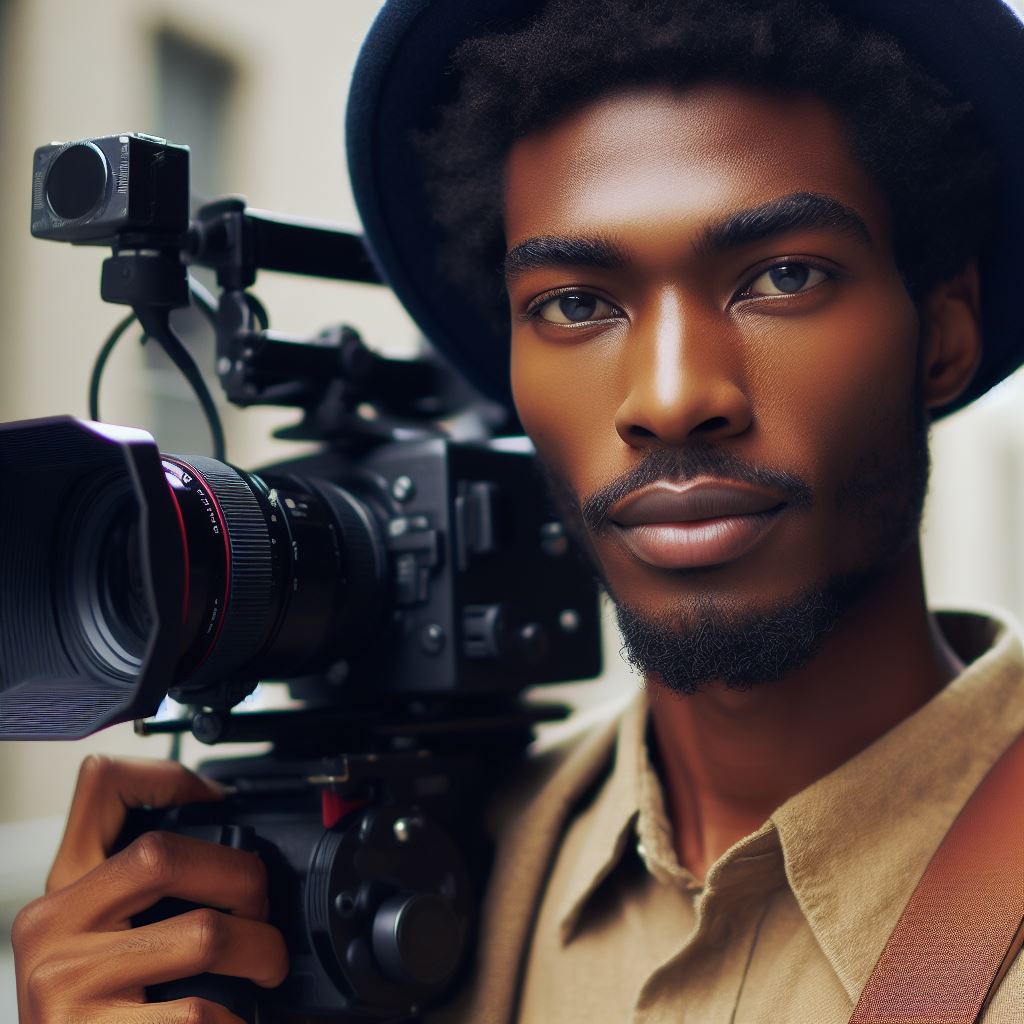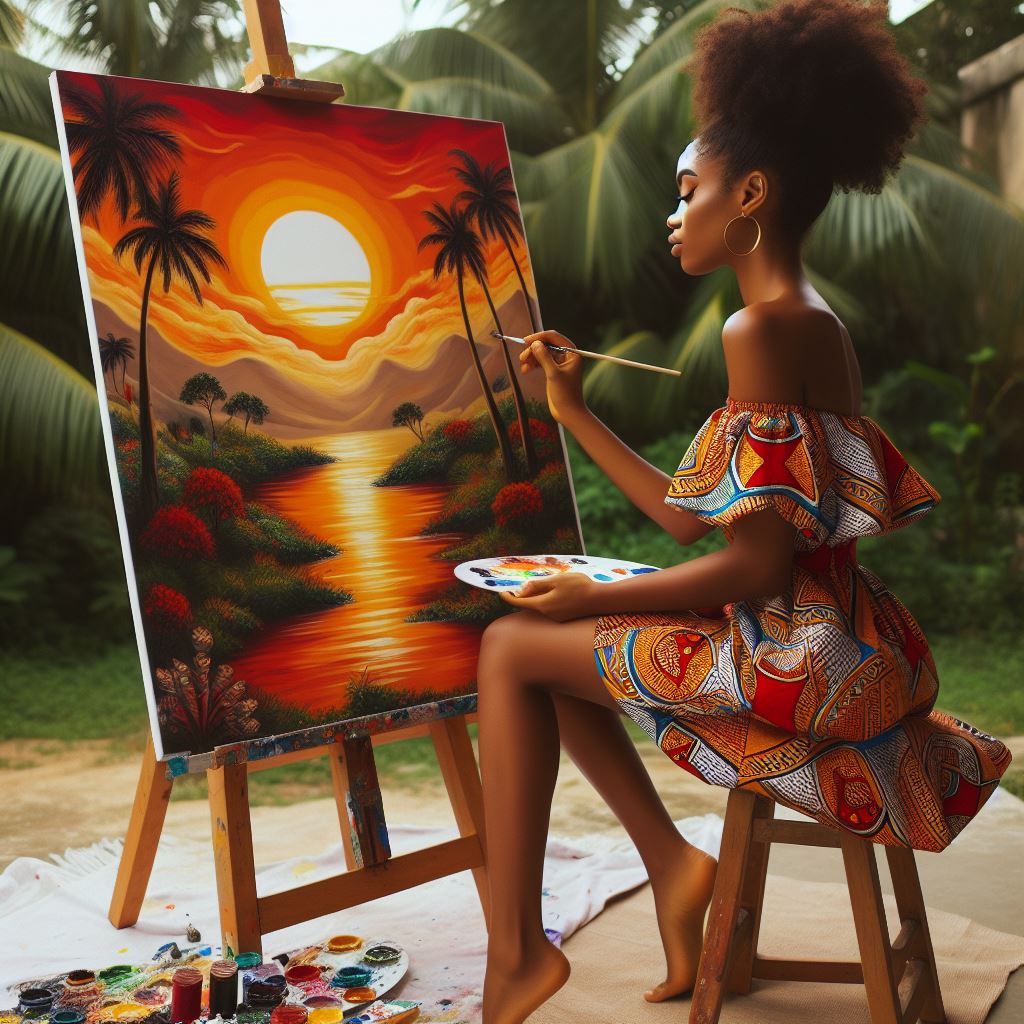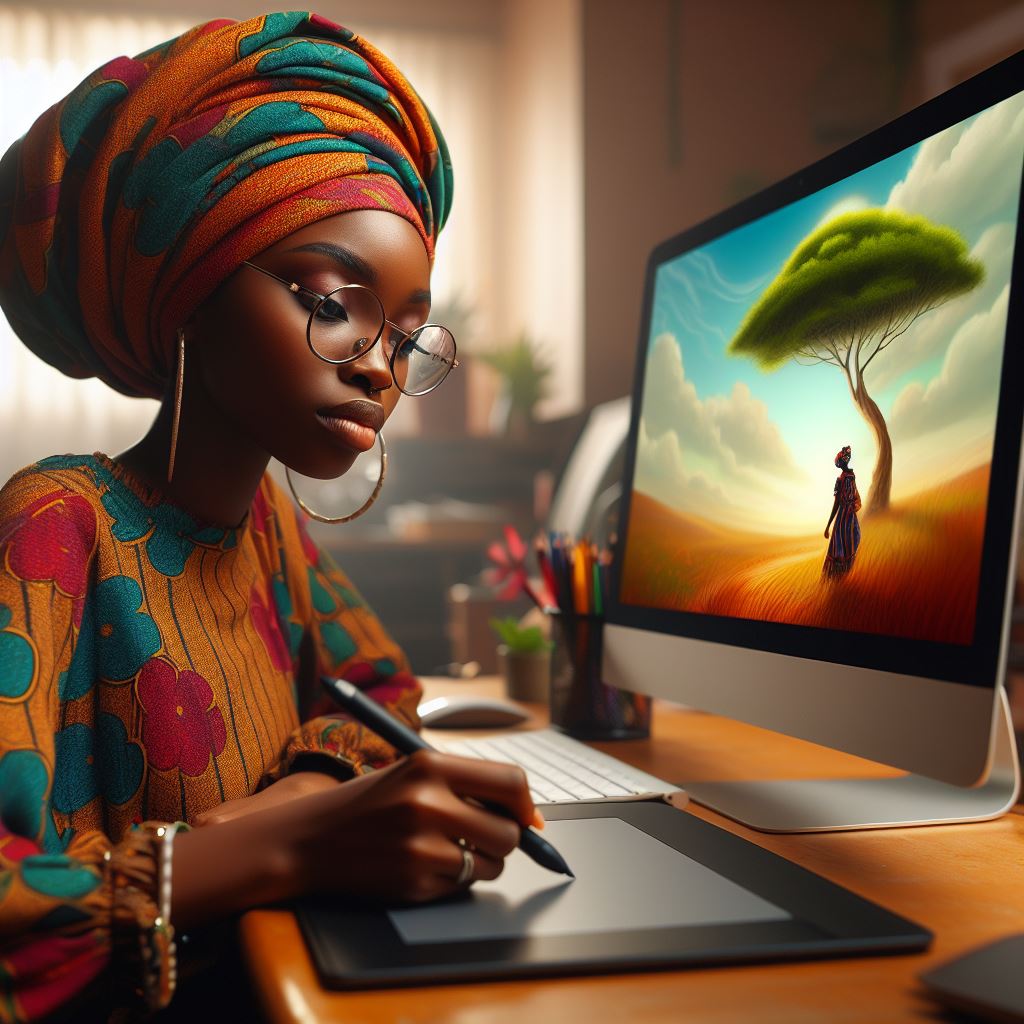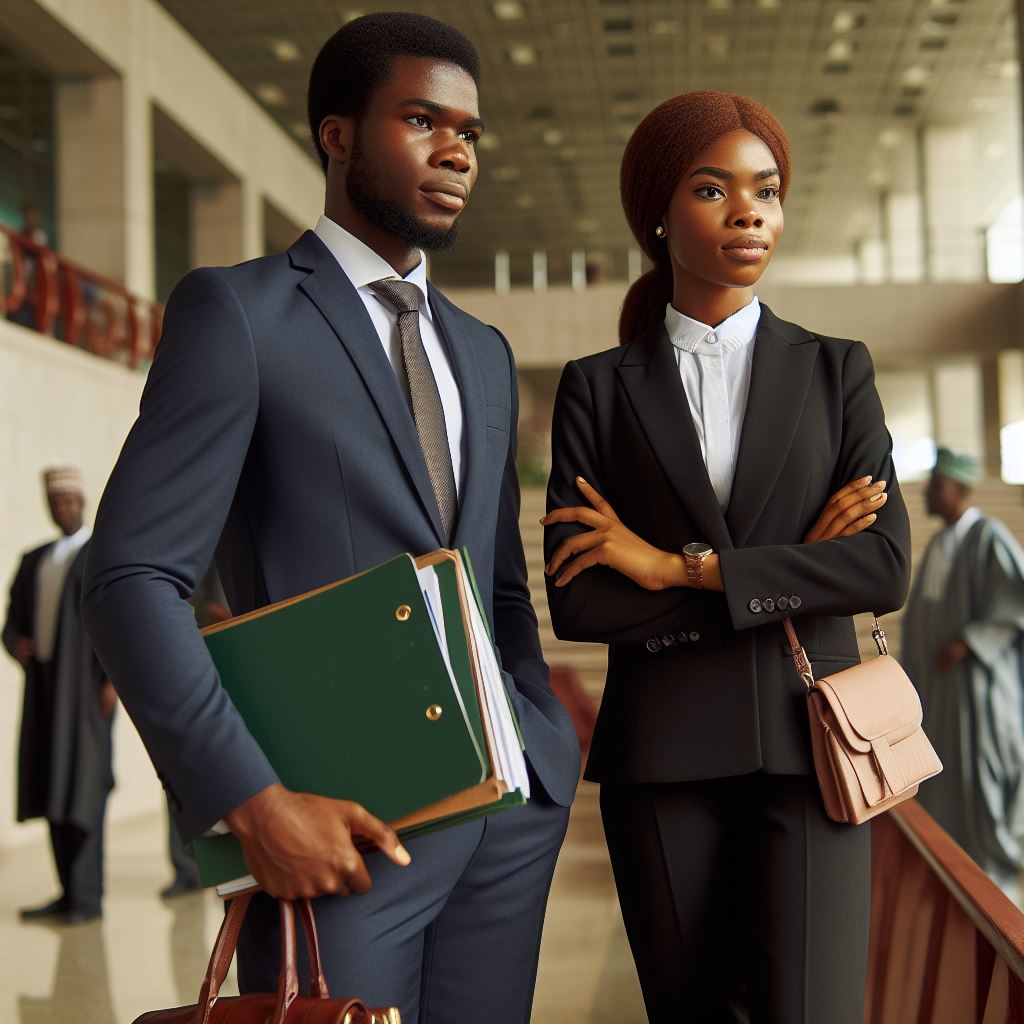Introduction
Nigerian visual and media arts have a rich and vibrant history. These arts reflect the country’s diverse cultural heritage and dynamic society.
Over time, they have evolved, showcasing both traditional and contemporary elements.
Brief Overview of the Historical Context
Nigerian visual arts date back thousands of years. Ancient Nok terracotta sculptures are among the earliest examples.
The Ife and Benin kingdoms produced intricate bronze and ivory artworks. These historical artifacts highlight Nigeria’s advanced early artistic skills.
Colonialism brought significant changes to Nigerian art. European influences mingled with traditional styles, creating unique hybrid forms.
Post-independence, Nigerian artists began exploring new themes, blending indigenous and modern techniques.
Significance of Visual and Media Arts in Nigerian Culture
Visual and media arts are crucial in Nigerian culture. They preserve and communicate historical and cultural narratives.
These arts serve as a medium for political and social commentary.
Art in Nigeria fosters national identity and pride. It unites diverse ethnic groups through shared visual symbols and motifs.
Contemporary Nigerian artists address global issues, contributing to international dialogues through their work.
Key Figures and Movements in Nigerian Visual and Media Arts
Several key figures have shaped Nigerian visual and media arts. Aina Onabolu is regarded as the father of modern Nigerian art.
He introduced Western techniques into Nigerian painting.
Ben Enwonwu, a prominent sculptor and painter, gained international recognition. His work bridges traditional and modern styles.
Bruce Onobrakpeya’s innovative printmaking has had a significant influence. The Nsukka School is a notable movement in Nigerian art.
Artists like Uche Okeke and Chike Aniakor developed the “Ulism” style, combining traditional Igbo designs with modern art forms.
This movement has left a lasting impact on contemporary Nigerian art.
In recent years, the digital revolution has transformed Nigerian media arts. Artists now explore new media, including digital installations and video art.
This shift has expanded the reach and impact of Nigerian art globally.
Nigerian visual and media arts continue to evolve, reflecting the country’s rich heritage and contemporary issues.
These arts play a vital role in cultural expression and social commentary.
Key figures and movements have significantly influenced the trajectory of Nigerian art, ensuring its dynamic presence in the global art scene.
Traditional Art Forms
Traditional Nigerian art forms such as pottery, textiles, and sculpture have a rich history and cultural significance.
Description of Traditional Nigerian Art Forms
Pottery in Nigeria is often characterized by intricate designs and vibrant colors, reflecting the diversity of Nigerian culture.
Textiles, on the other hand, showcase traditional patterns and symbols, with each design holding specific meanings and stories.
Sculpture in Nigeria ranges from wooden carvings to metal works, each representing different aspects of Nigerian life and traditions.
Influence on Contemporary Visual and Media Arts
These traditional art forms have played a significant role in shaping contemporary visual and media arts in Nigeria.
Many artists draw inspiration from traditional Nigerian art, incorporating elements such as patterns, symbols, and techniques into their work.
Examples of Contemporary Artists
- Nnenna Okore: Known for her textile-inspired sculptures that pay homage to traditional Nigerian weaving techniques.
- Peju Alatise: Combines traditional Yoruba beadwork with modern sculpture techniques in her artwork.
- Uche Okpa-Iroha: Uses traditional Igbo motifs in his photography, merging past and present in his visual storytelling.
These artists exemplify how traditional Nigerian art forms continue to influence and inspire contemporary visual and media arts in the country.
Read: Scholarships for Chinese Studies Students in Nigeria
Influence of Colonialism
How Colonialism Shaped Nigerian Visual and Media Arts
Colonialism in Nigeria began in the late 19th century and lasted until independence in 1960.
During this period, the British colonial authorities exerted control over various aspects of Nigerian society, including art and culture.
Colonial powers viewed indigenous art forms as primitive and inferior, promoting Western art as more sophisticated and advanced.
As a result, Nigerian artists were exposed to European art traditions, leading to a shift in artistic expression.
Impact of Western Art Forms and Styles on Nigerian Artists
The introduction of Western art forms and styles had a profound impact on Nigerian artists.
Many embraced these new influences, incorporating elements such as perspective, realism, and chiaroscuro into their work.
Some Nigerian artists sought to merge Western techniques with traditional Nigerian art forms, creating a unique blend of styles.
This fusion of cultures gave rise to new forms of artistic expression that reflected the complexities of Nigeria’s colonial history.
Nigerian Artists Who Resisted Colonial Influences in Their Work
Despite the pervasive influence of colonialism, some Nigerian artists resisted Western art forms and styles, opting to focus on preserving and promoting indigenous art traditions.
These artists, known as cultural nationalists, rejected the imposition of foreign aesthetics and instead celebrated the richness and diversity of Nigerian art.
One prominent artist who resisted colonial influences was Ben Enwonwu, whose sculptures and paintings often depicted traditional Nigerian themes and motifs.
Transform Your Career with Expert Guidance
Get personalized mentorship consulting that’s tailored to your unique path. Our expert advice is actionable and exclusive.
Get StartedEnwonwu’s work celebrated the beauty of Nigerian culture and heritage, challenging the notion that Western art was superior.
Overall, the influence of colonialism on Nigerian visual and media arts was complex and multifaceted.
While colonialism introduced new artistic ideas and techniques to Nigeria, it also led to the marginalization of indigenous art forms.
Nigerian artists navigated these influences in different ways, ultimately shaping a diverse and vibrant artistic landscape that continues to evolve today.
Read: Why Study Chinese Language and Culture in Nigeria?
Rise of Nollywood
Overview of Nollywood, the Nigerian film industry
Nollywood, the Nigerian film industry, has seen an incredible rise over the past few decades.
Emerging in the early 1990s, Nollywood quickly became one of the largest film industries globally.
This industry churns out thousands of films each year, making it a cultural powerhouse in Africa and beyond.
How Nollywood has impacted Nigerian visual and media arts
Nollywood’s impact on Nigerian visual and media arts is profound. It has shaped contemporary Nigerian aesthetics and storytelling.
The industry’s vibrant narratives reflect the complexities of Nigerian society. These stories resonate with audiences, both locally and internationally.
Nollywood’s visual style, characterized by vivid colors and dynamic compositions, has influenced many Nigerian artists.
Nollywood films often explore themes such as family, tradition, and modernity. This exploration enriches Nigerian visual culture.
The industry’s success has also led to the growth of ancillary sectors, including fashion, music, and literature.
These sectors often draw inspiration from Nollywood’s rich visual and narrative styles.
Examples of popular Nollywood films and filmmakers
Popular Nollywood films and filmmakers have gained international recognition.
“Living in Bondage,” released in 1992, is considered the film that started Nollywood’s commercial boom.
This movie’s success paved the way for other blockbuster hits. “The Wedding Party” is another significant film, breaking box office records in Nigeria.
This romantic comedy showcased the industry’s potential for high production values and storytelling finesse.
Filmmakers like Kunle Afolayan and Genevieve Nnaji have also made significant contributions.
Afolayan’s films, such as “October 1” and “The Figurine,” blend historical and contemporary themes.
Nnaji’s directorial debut, “Lionheart,” was the first Nigerian film acquired by Netflix.
These filmmakers push the boundaries of Nigerian cinema, gaining accolades and expanding Nollywood’s global reach.
Nollywood continues to grow, innovate, and influence. Its rise is a testament to Nigeria’s creative resilience and cultural richness.
This dynamic industry remains a vital part of Nigeria’s visual and media arts landscape, inspiring new generations of artists and filmmakers.
Digital Age and Social Media
In today’s digital age, technology and social media have played a significant role in shaping Nigerian visual and media arts.
Artists across Nigeria have embraced digital platforms as a means to reach a broader audience and showcase their work.
Influence of Digital Technology and Social Media
Digital technology has provided artists with new tools and mediums to express their creativity.
Social media platforms have created a space for artists to connect with art enthusiasts and potential collectors.
Artists can now share their work instantly with a global audience, breaking geographical barriers.
The immediacy of social media allows artists to receive instant feedback and engage in real-time conversations with their audience.
Virtual exhibitions and online galleries have become popular, providing artists with alternative ways to showcase their work.
Utilizing Social Media for Promotion
Nigerian artists leverage social media platforms such as Instagram, Twitter, and Facebook to promote their art.
By sharing images, videos, and stories, artists can give their followers a behind-the-scenes look at their creative process.
Using hashtags and geotags, artists can increase their visibility and attract a larger audience to their profiles.
Collaborating with influencers and other artists on social media helps artists broaden their reach and gain new followers.
Social media also allows artists to announce upcoming exhibitions, art fairs, and events, creating buzz and generating interest.
Nigerian Artists Gaining International Recognition
Nigerian artists like Laolu Senbanjo have gained international acclaim through their digital presence.
Laolu’s unique style of body art caught the attention of Beyoncé, leading to a collaboration on her visual album, Lemonade.
Other Nigerian artists like Victor Ehikhamenor and Peju Alatise have been discovered by international curators through their online portfolios.
Through online platforms, Nigerian artists have been able to showcase their work to a global audience, attracting collectors and galleries from around the world.
Platforms like Artsy and Saatchi Art have helped Nigerian artists gain visibility and access opportunities that were previously limited to them.
Overall, the digital age and social media have revolutionized the way Nigerian artists create, promote, and showcase their work.
By embracing technology and digital platforms, artists have been able to expand their reach, gain international recognition, and connect with a global audience like never before.
Read: Career Opportunities with a Chinese Studies Degree

Contemporary Art Movements
Recent years have seen a surge in new art movements in Nigeria, reflecting the country’s vibrant cultural scene and the evolving nature of contemporary art.
Two prominent movements that have gained traction in the Nigerian art scene are Afropolitanism and Afrofuturism.
Afropolitanism
Afropolitanism is a cultural and philosophical movement that celebrates the diverse influences and identities of modern Africa.
It emerged as a response to globalization and diaspora experiences, highlighting the interconnectedness of African cultures with the rest of the world.
- Emphasizes multiculturalism and hybrid identities
- Challenges stereotypes and redefines African identity
- Incorporates elements from various cultures and traditions
In the realm of visual and media arts, Afropolitanism has influenced artists to create works that reflect the complexity and richness of African experiences in a globalized world.
Artists such as Njideka Akunyili Crosby, known for her intricate and multi-layered paintings exploring themes of cultural fusion and displacement, are at the forefront of this movement.
Afrofuturism
Afrofuturism is a speculative cultural movement that combines elements of science fiction, fantasy, and Afrocentrism to imagine alternative futures for people of African descent.
It seeks to reframe narratives of the African diaspora and envision progressive, technology-driven societies.
- Explores themes of technology, identity, and empowerment
- Critiques historical and contemporary social issues
- Reimagines African and diasporic histories
In Nigerian visual and media arts, Afrofuturism has inspired artists to create futuristic and fantastical artworks that challenge conventional perceptions of African cultures and histories.
Artists like Victor Ehikhamenor, with his eclectic mix of traditional Nigerian motifs and futuristic aesthetics, are pushing the boundaries of Afrofuturist art in Nigeria.
Impact on the Nigerian Arts Scene
Both Afropolitanism and Afrofuturism have significantly influenced the trajectory of Nigerian visual and media arts, shaping the themes, styles, and techniques of contemporary artists.
These movements have provided a platform for Nigerian artists to engage with global discourses while celebrating their unique cultural heritage.
Key artists such as Njideka Akunyili Crosby, Victor Ehikhamenor, and others associated with these movements are garnering international acclaim for their innovative and thought-provoking works.
Their creations have opened up new avenues for artistic expression and dialogue, highlighting the dynamism and creativity of the Nigerian arts scene.
Read: Top Nigerian Universities Offering Chinese Studies
Challenges Faced by Nigerian Artists
Challenges Nigerian artists face in the industry
Being an artist in Nigeria comes with its own set of challenges that can hinder the growth and development of visual and media arts in the country.
Some of the main challenges faced by Nigerian artists include:
- Lack of Funding: Nigerian artists often struggle to secure adequate funding for their projects.
This lack of financial support can limit their creative output and prevent them from fully realizing their artistic vision. - Lack of Recognition: Many Nigerian artists struggle to gain recognition both locally and internationally.
This lack of exposure can make it difficult for artists to build a following and establish themselves in the art world.
Impact of Challenges on Visual and Media Arts Development
These challenges have a significant impact on the development of visual and media arts in Nigeria.
Without sufficient funding and recognition, artists are unable to fully explore their creativity and bring their ideas to fruition.
This stifles artistic innovation and limits the diversity of voices and perspectives in the art industry.
Additionally, the lack of support for artists can lead to talented individuals abandoning their artistic pursuits in search of more stable and lucrative careers.
This brain drain deprives the art industry of valuable talent and contributes to the perpetuation of the challenges faced by Nigerian artists.
Suggestions for Addressing These Challenges
In order to address the challenges faced by Nigerian artists, several strategies can be implemented:
- Increased Government Funding: The Nigerian government can allocate more resources to support the arts, including funding for grants, scholarships, and cultural initiatives.
This financial support can help artists pursue their creative endeavors without the constant worry of financial instability. - Establishment of Artist Residencies and Fellowships: Creating opportunities for artists to participate in residencies and fellowships can provide them with the resources and time needed to focus on their artistic practice.
These programs can also help artists network with other creatives and gain exposure in the art world. - Promotion of Nigerian Art and Artists: Increasing the visibility of Nigerian art and artists through exhibitions, publications, and online platforms can help raise awareness and appreciation for the country’s artistic talents.
This recognition can attract more support and investment in the art industry. - Support for Art Education: Investing in art education programs can help nurture the next generation of Nigerian artists and provide them with the skills and knowledge needed to succeed in the industry.
By supporting art education, the government and private sector can ensure a sustainable future for the art community.
By addressing these challenges and implementing strategies to support Nigerian artists, the development of visual and media arts in Nigeria can be fostered and enriched.
With increased funding, recognition, and support, artists in Nigeria can thrive creatively and contribute to the vibrant cultural landscape of the country.
Cultural Identity and Representation
As Nigerian visual and media artists continue to make their mark on the global stage, the way they navigate issues of cultural identity and representation is crucial.
Artists’ Perspective on Cultural Identity
Nigerian artists often grapple with the complexities of their cultural identity in their work.
They explore themes such as tradition, heritage, and the impact of globalization on Nigerian society.
By incorporating elements of Nigerian culture into their art, these artists aim to celebrate their roots and showcase the richness and diversity of Nigerian heritage.
Through their work, they challenge stereotypes and misconceptions that may exist about Nigerian culture.
Addressing Stereotypes and Misconceptions
One common misconception about Nigerian culture is that it is monolithic.
However, Nigerian artists are quick to dispel this notion through their diverse and varied artistic expressions.
They use their art as a tool to showcase the multifaceted nature of Nigerian identity, highlighting the different ethnicities, languages, and traditions that make up the country.
In doing so, they provide a more nuanced and accurate representation of Nigerian culture.
Promoting Positive Representations
Some Nigerian artists go beyond challenging stereotypes and actively work to promote positive representations of Nigeria.
They use their platform to showcase the beauty, vibrancy, and resilience of Nigerian culture.
These artists create art that celebrates Nigerian achievements, traditions, and values, painting a more holistic picture of the country that goes beyond the negative narratives often portrayed in the media.
Through their work, they inspire pride and appreciation for Nigerian culture.
In a nutshell, Nigerian visual and media artists play a vital role in shaping perceptions of Nigerian culture.
Through their art, they navigate issues of cultural identity and representation, addressing stereotypes and promoting positive narratives about Nigeria.
By engaging with these themes, artists help to foster a deeper understanding and appreciation of the rich and diverse cultural heritage of Nigeria, paving the way for a more inclusive and nuanced portrayal of the country in the global arts scene.
Conclusion
From the rise of digital art to the renaissance of traditional Nigerian art forms, there is a wealth of creativity and innovation happening in the visual and media arts scene in Nigeria.
As technology continues to progress and the global art market expands, Nigerian artists have the opportunity to reach a wider audience and showcase their unique perspectives.
There is great potential for growth and innovation in the Nigerian visual and media arts sector.
It’s essential to support Nigerian artists by attending exhibitions, purchasing art pieces, and sharing their work on social media platforms.
By actively engaging with Nigerian artists and their creations, we can help amplify their voices and contribute to the vibrant cultural landscape of Nigeria.




